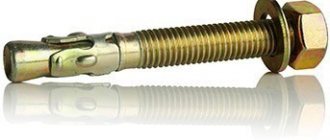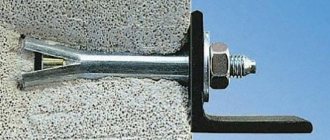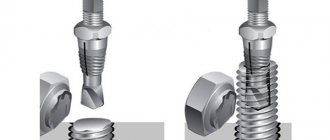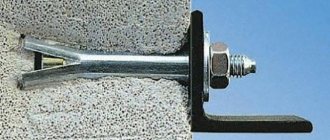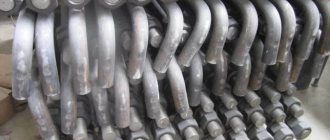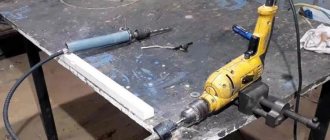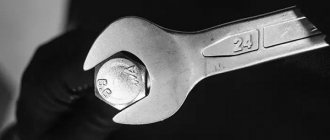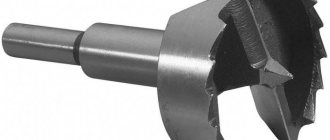An anchor bolt with a ring is a fairly universal fastening element that is convenient to use not only for mounting chandeliers and lamps, but also for fastening objects for other purposes on the surfaces of building structures. The ease of use and reliability of such fasteners are ensured by the features of its design.
An anchor with a ring paired with a carabiner is used to secure cables or wires
Design and operating principle
The basis of the anchor bolt with a ring is a metal pin. Its one end is made in the form of a ring. At the other end there is a conical nut. The stud has a metric thread knurled on it. There are longitudinal slots on the body of the cylindrical spacer coupling (bushing). They usually form up to 4 petals. A flat washer included in the design of an anchor bolt with a ring is not classified as an independent fastener. Its use ensures uniform distribution of the load on the surface of the installed element of the mounted structure. Another mandatory component of the fastener in question is a hex nut, from which protrudes a rod ending in a ring.
The operating principle of this type of anchor bolt is based on the movement of the sleeve along the rod when tightening the hex nut:
- the lower edge of this coupling slides along the conical surface of the lower nut;
- the slots open;
- the resulting petals rest against the inner surface of the mounting hole, thereby ensuring reliable fixation of this fastener in the base.
Actually, the same effect is observed when screwing the rod using a ring-shaped tip into the lower conical nut included in the design of the anchor bolt of the type in question. The only difference is that in this case it is not the bushing that moves. She remains motionless. Its slots expand due to the movement of a conical nut up the rod (it can also have a pyramidal shape). The result is the same: the anchor bolt is very securely fixed in the material of the mounting base.
Double spacer anchors with ring
A fastening element such as a double-spacer anchor with a ring makes it possible to obtain connections that are characterized by increased strength and reliability. It is used in cases where it is necessary to fasten objects of significant mass in building structures made of porous and even hollow materials. The reliability of fastening the anchor with the ring is ensured by the design features of such a fastener.
The ring of a double-spacer anchor is welded to prevent bending
The basis of such an anchor bolt are two (and in some cases three) sleeves, each of which is released when a threaded rod is tightened, acting on them with its conical tip. Due to this design, a fastener of this type ensures high reliability of the bolt, the installation of which is carried out even in very loose and hollow building materials. Taking into account the fact that significant effort is required to simultaneously release two spacer elements, the design of such an anchor bolt includes a special nut that is welded onto a threaded rod under the ring. The big advantage of having this nut is that its use does not damage the ring, which is not used to tighten the fastener.
Double-expansion anchor bolts with a ring in the upper part are successfully used when performing rigging work when it is necessary to fix the position of a massive chain or metal cable of significant diameter. Design features allow such fasteners to successfully withstand even very significant static and dynamic loads.
Application
The areas of application of an anchor bolt with a ring-shaped tip are determined by its design. In particular, this fastener is widely used when it is necessary to mount suspended objects on the ceiling and walls. These could be, for example, expensive massive chandeliers. He will also come to the rescue when you need to establish a point for fixing a rope, cable, or rope.
The construction industry cannot do without such fasteners. Moreover, here an anchor bolt with a ring-shaped tip is used very actively. In particular, it is used to form a reliable connection between scaffolding and load-bearing walls of a structure being repaired or newly constructed.
However, in this case there are difficulties. They are as follows:
- before installing fasteners of this type, you need to evaluate the quality of the mounting base;
- reliable fixation will be ensured only in installation materials characterized by a dense internal structure - natural stone, solid ceramic brick, as well as concrete;
- The operating efficiency of an anchor bolt with a ring-shaped tip, equipped with a spacer sleeve with a classic design, in mounting bases with internal voids (for example, in slotted bricks) is very low.
How does an anchor bolt with a ring and its modifications work?
Theoretically, such fasteners should withstand the pullout load placed on it and sit very tightly in the mounting hole. From a practical standpoint, this is what happens with the anchor. After all, the fastening is based on the holding method of expansion, which is by far the most effective method among the devices of anchor bolted structures. The spacer effect is created at the moment the bolt is tightened; that same cone-shaped nut begins to gradually screw into the sleeve and expand it .
Specifications
In order to correctly select, reliably install and subsequently operate an anchor bolt with a ring-shaped tip for a long time, it is necessary to study its technical characteristics. For all standard sizes of fasteners of this type, the values of the most important parameters are presented in the table.
| Standard size | M.PF | L1 | L | D1 | D2 | D3 |
| M20×200 | 5,1 | 155,0 | 200,0 | 16,0 | 20,0 | 40,0 |
| M20×150 | 105,0 | 150,0 | ||||
| M20×90 | 60,0 | 90,0 | ||||
| M20×75 | 48,0 | 75,0 | ||||
| M16×200 | 3,7 | 180,0 | 200,0 | 12,0 | 16,0 | 20,0 |
| M16×180 | 160,0 | 180,0 | ||||
| M16×160 | 122,0 | 160,0 | ||||
| M16×130 | 102,0 | 130,0 | ||||
| M16×100 | 72,0 | 100,0 | ||||
| M16×80 | 55,0 | 80,0 | ||||
| M16×60 | 45,0 | 60,0 | ||||
| M14×195 | 3,0 | 175,0 | 195,0 | 14,0 | 15,0 | |
| M14×100 | 80,0 | 100,0 | ||||
| M14×70 | 53,0 | 70,0 | ||||
| M12×130 | 2,5 | 119,0 | 130,0 | 10,0 | 12,0 | 14,0 |
| M12×100 | 81,0 | 100,0 | ||||
| M12×70 | 59,0 | 70,0 | ||||
| M10×130 | 1,7 | 115,0 | 130,0 | 8,0 | 10,0 | 12,0 |
| M10×115 | 100,0 | 115,0 | ||||
| M10×100 | 85,0 | 100,0 | ||||
| M10×80 | 60,0 | 80,0 | ||||
| M10×70 | 50,0 | 70,0 | ||||
| M10×60 | 40,0 | 60,0 | ||||
| M10×50 | 30,0 | 50,0 | ||||
| M8×85 | 1,2 | 70,9 | 85,0 | 6,0 | 8,0 | 10,0 |
| M8×45 | 40,0 | 45,0 | ||||
| M8×40 | 35,0 | 40,0 |
The following designations are used in the table:
M.P.F – minimum pull-out force (Minimum Pulling Force), material – concrete B25. The unit of measurement is kilonewtons (kN);
L1 – length of slotted sleeve;
L – length of the rod from the lower plane of the conical spacer nut to the upper thread:
D1 – diameter of the transition of the ring to the threaded rod;
D2 – larger diameter of the conical spacer nut;
D3 – inner diameter of the ring
Design Features
Anchor bolts consist of the same elements:
- regular hex nut;
- washer – distributes pressure when tightening the bolt;
- slotted spacer;
- a flare nut that will fit into the spacer sleeve;
- rod with external thread.
This is a spacer sleeve
. The spacer sleeve expands when the flare nut is inserted into its body.
The flare nut has entered the spacer sleeve
As a result, the friction force increases sharply.
This is how the spacer sleeve expands
The thickness of the fasteners varies: M6, M8, M10, M12 and more up to M28. The length also differs - anchor bolts can be short or very long, up to 300 mm.
Anchor bolts are made from various steels:
- carbon - the simplest and most affordable;
- stainless – alloys of grades A1, A2, A3 are used;
- galvanized – zinc is applied by galvanic spraying and protects fasteners from corrosion;
- brass - this alloy itself perfectly resists corrosion; brass fasteners can be installed even under water.
Brass fasteners do not rust
Material of manufacture
Ring-end anchor bolts are made from a variety of raw materials. In particular:
- carbon structural steel without protective coating. For example, for the production of such fasteners with strength class 8.8, the following grades are used: St.45 and St.35;
- Cink Steel. The protective coating is applied to anchor bolts with a ring, mainly by the galvanic method. The thickness of the formed layer ranges from 6 µm…9 µm;
- stainless steel alloys. These steel grades are: A4 and A2. Their closest domestic analogues are 10Х17H13M12 and 08Х18H10, respectively;
- colored alloy brass. This material, along with high ductility, is also characterized by excellent anti-corrosion properties. Fasteners made from it can be successfully used not only in conditions of high humidity, but even installed and operated under water. Brass used for the production of anchor bolts with a ring-shaped tip must be foundry grade. These are, for example, brands such as L38Mts2C2, LTs40Mts3A and LTs40Mts3Zh.
Varieties and principle of operation
The expansion principle of the ring anchor bolt is the most effective fastening method available today. The sleeve of such a bolt, placed in the hole, expands during the process of tightening the threaded element, thereby forming a reliable adhesion with its inner walls. To maximize the expansion of the spacer sleeve, the lower part of the threaded element is given a conical shape.
High-strength ring anchor (eye bolt) has four expansion segments and is well secured in deviated holes
An anchor bolt, at the end of which there is a fastening ring, can be made of various types of metal alloys, which experts recommend taking into account when choosing and installing such a product.
Carbon steel without coating
This is the simplest option for manufacturing anchor bolts, which are affordable.
Zinc coated steel
A layer of zinc is applied to steel using the galvanic method. The zinc coating reliably protects the anchor bolt from negative environmental factors.
Stainless steel alloys
Alloys of grades A1, A2 and A3 are mainly used as such materials. Depending on the grade of steel, bolts differ in both their technical and operational characteristics.
Brass
This is a material that has not only high ductility, but also exceptional resistance to corrosion. Anchor fasteners, the elements of which are made of brass, can not only be successfully used at high humidity, but also installed under water.
To solve problems associated with the installation of objects in various building materials, you should select the appropriate fasteners. Only under this condition can the required reliability of the formed connection be guaranteed.
Drawing of an anchor bolt with a ring
Technical Specifications of Ring Anchor Bolts
When choosing a fastening element such as a bolt, the upper part of which is a ring, you should also take into account its dimensions, in particular the length of the leg. Modern manufacturers produce bolts, the length of the working part of which starts from 70 mm and can reach up to 165 mm. The variety of sizes of the working part of such fasteners allows you to select them for installation in building structures made of material with varying degrees of density.
Installation
Installation of an anchor bolt of this type is performed as follows:
a hole is drilled in the mounting base. The diameter of the socket should be equal to the value of this indicator of the slotted sleeve, and the depth should be equal to the length of the entire working section of the fastened hardware;
then the hole must be thoroughly cleaned from dust and particles of the mounting base material formed during drilling. For this you should use a medical rubber bulb, a brush with hard bristles, a vacuum cleaner or a regular pump, as shown in the figure;
a fastener is inserted into the hole and moved with light blows of a hammer so that in the end only the washer, nut and ring remain on the surface of the base;
then, using an open-end wrench, you need to tighten the hex nut until it stops;
Finally, you need to make 2-3 turns with the ring itself. This will cause the rod to finally screw into the cone-shaped spacer nut. This completes the installation of the anchor bolt of the type in question.
Description, design and characteristics of the product
Anchor bolts equipped with a ring are a kind of fastening that has a high pull-out strength. Sleeve fasteners are not used to hold two objects together at the same time. It acts as a structure for hanging or stretching.
As a rule, this type of fastener is used for use on a concrete or brick base. You can attach the eye anchor to a natural stone surface. There are several structurally important elements of the product:
1. A rod with an end bent into a ring. On the back of the rod there is a thread for screwing in. 2. There is a nut under the ring. Sometimes manufacturers complete the fasteners with a steel washer. 3. Housing (acts as a bushing). At one end of the part there is a part of the sleeve with slots that act as a release mechanism. On the other side of the body there is a cap. 4. Spacer nut. Its ends have different shapes. The element has a longitudinal section.
It is easy to install a bolt anchor with a ring without specialized knowledge. You need to make a hole in the work surface using a hammer drill. Please note that the drill parameters must match the length and diameter of the fastener. It is imperative to get rid of construction dust and debris inside. A brush is used for this. If it is not possible to completely clean the hole, then it is better to make it about 0.2 centimeters longer than the actual length of the anchor.
An anchor bolt with a ring is inserted into the prepared place and driven in with a hammer or mallet. Then you need to screw the ring all the way. Typically, 3 to 5 turns will be needed. The final position of the ring is selected based on further operating conditions.
How to install an anchor correctly - step-by-step diagram
Step 1: Drill a hole
First of all, we need to drill a hole into which our mount will later fit. To do this, insert a drill bit into the hammer drill chuck and drill a hole to the depth of the length of our bolt.
Step 2: Clean the hole from dust
As a rule, after drilling, a lot of concrete chips remain in the hole for anchor fasteners; it must be removed from the hole, preferably all of it. Otherwise, the remaining concrete dust after working with a drill will not allow the anchor sleeves to fit tightly into the wall. In order to thoroughly clean the hole, you can use a vacuum cleaner, which will remove as much dust as possible.
